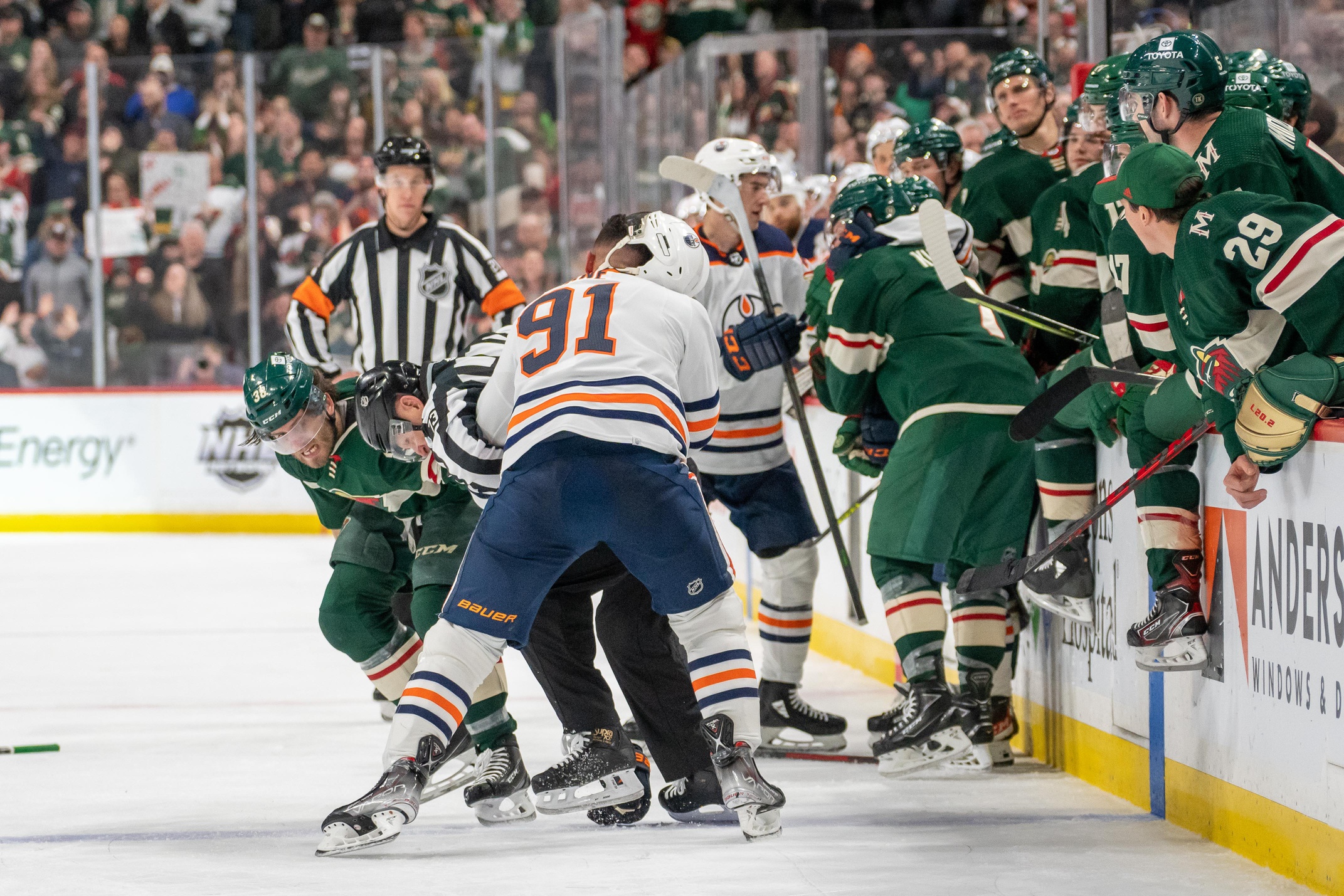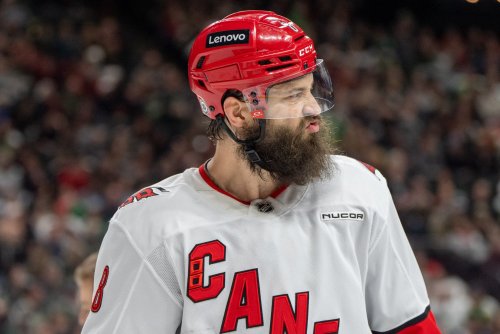
Bill Guerin and Director of Amateur Scouting Judd Brackett have been on a hot streak in the past few drafts. Despite holding only one top-10 pick, they’ve consistently landed high-end scoring talent and built one of the league’s best prospect pools.
How do they do it? Mostly, they’ve leaned into the market for undersized prospects. As a result, they have a prospect pool highlighted by skilled, undersized players:
Forwards:
- Riley Heidt, 5-foot-10
- Danila Yurov, 6-foot-1
- Marat Khusnutdinov, 5-foot-9
Defense:
- Brock Faber, 6-foot-1
- Carson Lambos, 6-foot-1
- Daemon Hunt, 6-foot-1
- Jack Peart, 5-foot-11
- Ryan O’Rourke, 6-foot-2
Of these prospects, all are age 20 and older aside from Heidt (age 19), meaning they likely aren’t growing any taller. Not all of these players will remain with the Wild, but many will for most of their careers. And if these small prospects find their way onto the Wild roster, the team must find ways to protect them.
Minnesota’s players have suffered injuries at an astounding rate this year. Every team deals with injuries in a contact sport, but the Wild are dealing with something abnormal in hockey. Furthermore, it’s noteworthy that many of their injuries have happened to smaller players.
Per Minnesota’s injury report, Jared Spurgeon (5-foot-9) has missed 25 games due to injury. Mats Zuccarello (5-foot-7) missed nine, Kirill Kaprizov (5-foot-10) missed six, and Ryan Hartman (5-foot-11) missed three. Even Jonas Brodin, who has missed 14 games, is 6-foot-2*. Most NHL defensemen are taller and heavier than Brodin. Minnesota has leaned on all five players in starting roles for the past two seasons.
The Wild knows that their top players are undersized, so they have employed enforcers such as Marcus Foligno, Ryan Reaves, Nic Deslauriers, and Pat Maroon to protect them. For whatever reason, that hasn’t been enough.
Minnesota’s enforcers did not deter Evander Kane from boarding Brodin. Brendan Dillon wasn’t intimidated when he cross-checked Kaprizov twice. With all due respect to Jake Middleton, I don’t think his fight with Dillon will discourage him from similar cross-checks in the future. Hartman’s high-stick on Cole Perfetti will likely only escalate the situation.
Minnesota’s enforcers aren’t preventing other teams from taking liberties, and the Wild’s players aren’t getting any bigger. So how can they protect their diminutive stars, now and in the future?
To my mind, the best alternative to the old-school enforcer is an efficient power play. If Minnesota rides into town with a top-five power play unit, opposing coaches would emphasize to their team that they must stay out of the penalty box. Suddenly, those shots to Kaprizov’s ribs turn from a veteran hockey play into a stupid mistake.
Minnesota’s power play ranks 21st in the league this year, scoring 18.2% of the time. But the analytics show that it may be even worse than that. Per MoneyPuck.com, they rank 30th in expected goals (xG) per minute, which indicates they’ve been lucky to face below-average goaltending. So why would their opponents be afraid to take liberties with the Wild’s best players?
Unfortunately, the Wild don’t have a reputation for a terrifying power play. Outside the State of Hockey, this team is regarded as a band of goons living on the rulebook's edge, and teams know how to burn them for that behavior.
Bally Sports North play-by-play announcer Anthony LaPanta put it succinctly in a recent episode of the Worst Seats in the House Podcast:
They’ve earned the reputation. They shouldn’t be absolved of guilt. They’ve been a team that’s not been very disciplined. I’m not going to say they’ve been dirty, but they’ve been one of the least disciplined teams over the last couple of years. And I think that’s hurt them in all these spots.
And I think it’s from verbally getting after officials to players that just have not been able to toe that line. And now you’ve heard coaches come out and say it. You heard Dallas deal with that in the playoffs, you heard Winnipeg say the same thing -- that if they’re going to play that way, we got to make them pay on the power play. Coaches now are coming and saying it … you can’t unhear things. Referees hear things, too.
There’s no debating that Minnesota takes too many penalties. According to Hockey Reference, they’ve given up the sixth-most Power Play Opportunities Against (PPOA), and it’s become part of the team’s identity. During last year’s playoffs, Dallas Stars coach Peter DeBoer called the Wild out for how often they took penalties. It certainly seems like Minnesota has a reputation with the refs. Perfetti’s allegation that Hartman intentionally high-sticked him solidifies that reputation even further.
Minnesota’s dismal PK compounded that problem. The Wild currently have the league’s third-worst penalty kill with a PK% of 72.4%.
In short, Minnesota’s reputation for taking penalties seems counter-productive to protecting its stars. It puts the Wild on the penalty kill more often when they retaliate. Hartman’s penalty after Kane injured Brodin is a perfect example. Since Hartman was penalized and Kane was not, the Oilers were essentially rewarded for Kane’s dangerous hit, which injured Brodin.
Perhaps that’s why Minnesota’s stars are getting hurt despite the presence of enforcers. Teams may not be afraid of the Wild retaliating. Instead, they see it as an opportunity to shell Minnesota’s horrendous penalty kill. Not only do opposing coaches disregard Minnesota’s power play, but they probably encourage their players to goad the Wild into taking more penalties.
It’s getting to the point that Minnesota’s season can be summed up in one word: injuries. It’s always a shame when it comes to that point. It’s not interesting to watch and doesn’t make a good story. And injuries are, of course, devastating to the players themselves.
Foligno and Maroon’s presence didn’t stop it this year, so who’s to say it will stop it in the future? If the team wants to address this madness, they may need to get creative. If players can’t police the game with their fists, they’ll need to do it with their play on the ice.
Fixing their goon-squad reputation is the first step in that direction.
*We initially had Brodin at 6-foot-1. The Wild list him at 6-foot-2. We regret the error.
Think you could write a story like this? Hockey Wilderness wants you to develop your voice, find an audience, and we'll pay you to do it. Just fill out this form.
-
 1
1




.thumb.jpg.a9b35df58693aa7a574a96bc7e6aac74.jpg)


Recommended Comments
Join the conversation
You can post now and register later. If you have an account, sign in now to post with your account.
Note: Your post will require moderator approval before it will be visible.